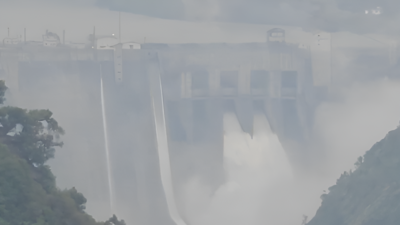India has opened several gates at the Baglihar Hydroelectric Power Project Dam on the Chenab River in Ramban, Jammu and Kashmir, as part of an ongoing effort to manage water discharge following heavy rainfall in the region. The move comes after the earlier opening of two gates on Saturday, as authorities aim to regulate the water levels and prevent flooding downstream.
The decision to open the gates was prompted by the substantial rainfall that the region experienced on Friday, which raised water levels at the dam. The gates were kept open from 8:30 am to 4:30 pm on Sunday, ensuring that the water release could be controlled in line with necessary safety protocols. This action followed a similar step taken earlier in the week, when two gates were also opened to manage the water flow, only to have them closed subsequently. The cycle of opening and closing the gates is part of a broader strategy to balance the dam’s water levels while ensuring downstream communities are not adversely affected.
The Baglihar Hydroelectric Power Project, which has long been a point of focus due to its significance in the region, operates as a critical source of power for Jammu and Kashmir. However, it has also been a point of contention between India and Pakistan. The dam’s operations often raise concerns, particularly regarding water flow regulations in the Chenab River, as Pakistan claims that the discharge of water could affect agricultural areas downstream.
While India maintains that the release of water from the Baglihar Dam is within the agreed-upon parameters under the Indus Waters Treaty, tensions over water management continue to exist. The Indus Waters Treaty, which was signed between India and Pakistan in 1960, governs the usage of the waters of the Indus River and its tributaries. According to the treaty, the waters of the Chenab River, which are controlled by India at the Baglihar Dam, are primarily for Pakistan’s use, but India is entitled to use the water for hydroelectric purposes, subject to specific conditions.
In the past, the opening of the gates has often sparked diplomatic discussions. Both nations have expressed concerns at various points about how water discharge may affect their respective territories. Despite these challenges, both India and Pakistan have continued to work within the framework of the treaty, with the hope of maintaining regional cooperation over water sharing.
The Baglihar Dam, operational since 2008, has become a vital asset in India’s efforts to provide energy to the northern states, including Jammu and Kashmir. In addition to its role in hydropower generation, the dam is a significant feature in the complex water-sharing arrangement between the two nations. While the gates are used to regulate water flow during heavy rainfall or in the event of a risk of flooding, the exact timing and frequency of their operation can raise questions regarding transparency and adherence to the treaty’s provisions.
The release of water from the dam is typically accompanied by notifications to Pakistan, which is often informed about such developments well in advance. However, concerns remain about how quickly such information is disseminated and whether sufficient measures are in place to prevent potential damage to communities located downstream. Water management experts have underscored the importance of timely communication and proactive measures to mitigate flood risks when heavy rainfall is forecasted.
In this context, the challenge of managing water flow at the Baglihar Dam becomes a delicate balancing act. Authorities must account for the safety of those living near the dam, while also adhering to international agreements that govern water usage. Furthermore, the complexities of dealing with both environmental factors and diplomatic concerns make the operation of such infrastructure a sensitive issue.
The decision to open the gates was likely influenced by predictions of continuing rain, which could exacerbate the risk of flooding. Officials responsible for overseeing the dam’s operations have reiterated that they are taking all necessary precautions to prevent downstream communities from facing adverse consequences. The opening of the gates is part of an ongoing effort to ensure that the water flow does not exceed safe levels.
Despite the technical and environmental aspects of managing the Baglihar Dam, it remains at the centre of geopolitical discussions between India and Pakistan. Both countries have called for improved dialogue and cooperation to better manage water resources in the region. With the growing concerns surrounding water scarcity and climate change, this issue is expected to remain a focal point in discussions about regional stability and resource management.
As the water levels in the Chenab River continue to fluctuate, the role of infrastructure projects like the Baglihar Dam will remain crucial in managing the river’s flow. Both nations must continue to work together under the framework of the Indus Waters Treaty to ensure that water resources are shared equitably and sustainably. The current operational decisions at the Baglihar Dam serve as a reminder of the ongoing importance of international cooperation in managing transboundary water resources and addressing the complex challenges posed by natural disasters such as heavy rainfall.




 YouTuber’s On-Air Remark Strains India-Iran Relations
YouTuber’s On-Air Remark Strains India-Iran Relations 